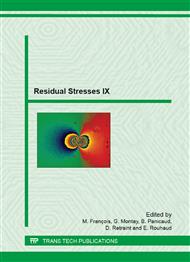p.769
p.775
p.782
p.788
p.794
p.801
p.808
p.814
p.820
Effects of Fatigue on the Integrity of a Friction Stir Welded Lap Joint Containing Residual Stresses
Abstract:
This research uses a non-destructive method of neutron diffraction to measure the tri-axial residual stresses in a friction stir welded aerospace fuselage component: a stringer-to-skin lap joint. Two different specimens were examined. Fatigue testing was performed on both specimens to determine their fatigue lives. Effects of the different components of residual stresses were examines and related to fatigue performance. A combination of fractography, hardness testing, and residual stress measurement was used to predict areas of high probability of structural failure in the friction stir welded lap joints.
Info:
Periodical:
Pages:
794-800
Citation:
Online since:
August 2014
Authors:
Permissions:
Share:
Citation:


